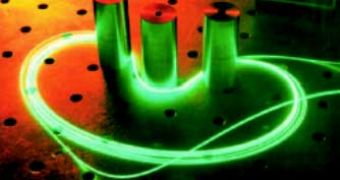The early 20th century brought us Albert Einstein, and with him the Theory of Relativity which he exploited to the maximum in order to satisfy his obsession with light and electromagnetic waves, thus postulating the possibility of building Light Amplification by Stimulated Emission of Radiation devices, or Lasers for short. Said and done, and in the 1960s the humankind developed the first working laser. But there seemed to be one little problem, as it was to no use.
Since then, however, humans found ways to efficiently include the laser devices in most of the essential industrial and scientific tools, such as in nanotechnology and biology. The telecommunication services also saw a great opportunity and developed new means of transferring data over large distances through optical fibers by using laser signals.
Nevertheless, electrical signals light loses its intensity while traveling through a material medium and needs amplification modules that involve an increased maintenance cost and a decrease in efficiency. In order to solve this problem, European scientists are developing a new technology that could eventually lead to the creation of a new generation of ultra-fast high-intensity fiber lasers.
Most of the high-intensity ultra-fast lasers available today are using solid state technology, thus the components that are used to build them are rather bulky and expensive. Fiber lasers could solve part of their problems, by eliminating the carrier medium with optical fibers.
Sponsored by the European Union, the so-called Uranus project has the main goal to develop ultra-fast lasers that can provide with light in different wavelengths, and the creation of fiber laser sources. One of the greatest challenges of the transmission of optical signal through optical fibers is represented by light dispersion. The Uranus project was successful at developing, for the first time, a special fiber made of ytterbium-doped photonic bandgap, that has a dual role, as signal carrier and beam dispersion compensation medium.
Furthermore, this supercontinuum source can provide with high frequency pulses at all wavelengths. It can be used to build smaller laser devices that have performances comparable to the solid-state ones, and uses less power to operate, due to the elimination of the air signal transmission medium, with fiber.
Optical fibers were incorporated in the telecommunication industry somewhere around 1990, and, after many tests, the designers decided to use diode pump laser systems to power them, due to the cheap solutions that they offered. The use of a similar performance solid-state laser, compared to the diode laser, implies costs at least three times higher.

 14 DAY TRIAL //
14 DAY TRIAL //